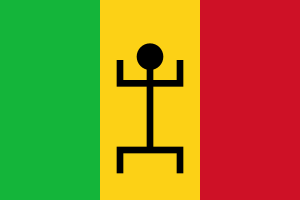Flag of Mali facts for kids
The flag of Mali is a colorful symbol of the country. It has three equal stripes that go up and down, from top to bottom. If you look at the flag from the side where it's attached to the flagpole, you'll see the colors are green, gold, and red. These three colors are known as the pan-African colours, which are often used by African nations to show their unity and independence.
Contents
What the Colors Mean
Each color on Mali's flag has a special meaning:
- Green stands for hope, the country's rich plant life, and the farming that is important to Mali.
- Gold represents the wealth of Mali, especially its gold mines. It also symbolizes the sun and the bright future of the nation.
- Red reminds everyone of the bravery and sacrifices made by the people of Mali to gain their independence.
How the Flag Changed Over Time
The flag we see today became the official flag of Mali on March 1, 1961. However, Mali had a slightly different flag before that.
The Original Flag (1959-1961)
The first official flag was adopted on April 4, 1959. This was when Mali joined with another country to form the Mali Federation. This early flag looked very similar to the current one, with the same green, gold, and red stripes.
But there was one big difference! The gold stripe in the middle had a black symbol on it. This symbol was a simple human-like figure, often called a kanaga. It looked like a stick figure with its arms pointing up towards the sky.
Why the Kanaga Was Removed
The kanaga symbol was removed from the flag on March 1, 1961. This change happened because of an important belief in Islam. Most people in Mali are Muslim, and their religion often discourages making pictures or statues of humans. To respect this belief, the kanaga symbol was taken off the flag, leaving the three plain stripes we see today.
Images for kids
See also
 In Spanish: Bandera de Malí para niños
In Spanish: Bandera de Malí para niños




